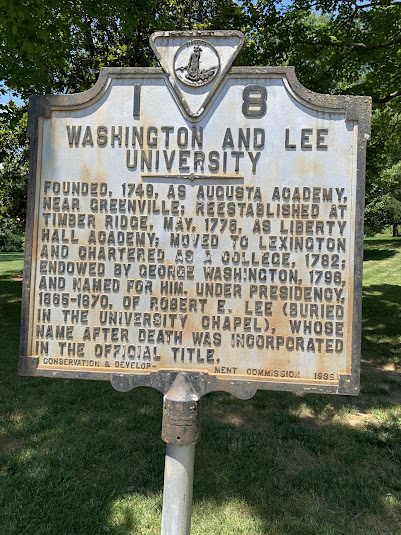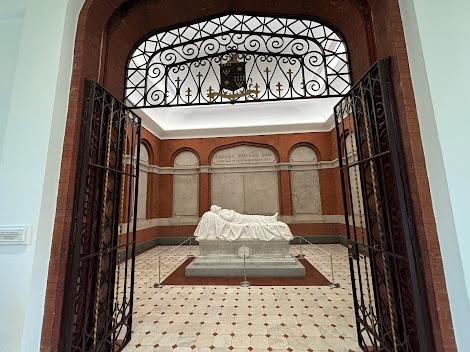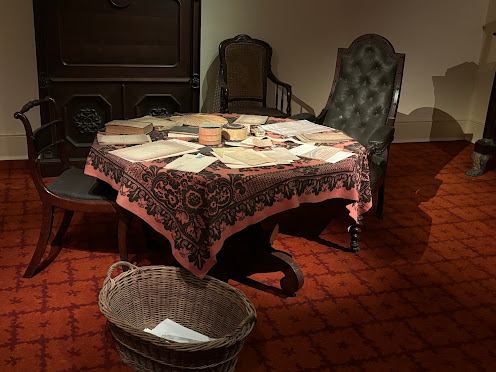In order to finish the story of the VMI cadets who fought in the Battle of New Market, we went to Lexington to visit two universities.
We visited Virginia Military Institute before but at the time we didn't know about the graves and memorial of the cadets who were killed at the Battle of New Market in 1864. So we came back to see the graves and pay our respects.
Virginia Mourning her Dead
This sculpture honors the ten cadets who fought and died after being wounded on the battlefield at New Market. Dedicated in 1903 and moved to its current location in 1912, the bronze sculpture was created by the artist Moses Ezekiel (remember him from the Thomas Jefferson statue at New Market Museum?). Ezekiel, born in Richmond, was the first Jewish cadet to attend VMI and served as a corporal in the color guard during the Battle of New Market. He graduated in 1866.
Individual grave markers for the fallen cadets are visible behind the base of the sculpture. Remains of six of the young men who died are set in a copper box inside the foundation of the monument; the other four cadets are not buried at VMI.
A ceremony to commemorate the deaths is held every year at the monument on the anniversary of the battle. The name of each fallen cadet is called out; after each name, a cadet chosen for the ceremony replies "Died on the field of honor, Sir". Floral tributes, a prayer, and a three-volley gun salute are then followed by a rendition of "Taps" and the hymn "Amazing Grace."
From there we went back to Washington & Lee University (next door to VMI), another place we'd visited before. Our first visit was to see the grave of Robert E. Lee but the area was under construction and we were unable to view it. So since we were here.....
The University Chapel was constructed from 1867-1868 at the request of Robert E. Lee, who was president of the school (then known as Washington College). The Victorian brick architectural design was probably the work of Lee's son, George Washington Custis Lee, with details contributed by Col. Thomas Williamson - both men were professors in the engineering department at VMI. Built of brick and native limestone, the Chapel was completed in time for graduation exercises in 1868. Lee attended weekday worship services here with the students and the lower level housed his office, the treasurer's office and the YMCA headquarters (student center).
Upon completion and during Robert E. Lee's lifetime it was known as the College Chapel. Lee was buried beneath the chapel in 1870.
There was a nice volunteer just waiting to escort us up to the front of the chapel and give us a brief overview.
Lee Chapel was officially renamed University Chapel on June 4, 2021 by the university's board of trustees. The university also announced the discontinuation of its school holiday known as "Founders Day", held on Robert E. Lee's birthday, and significant upcoming redesign and renovations of the Chapel to be overseen by the board "to restore its unadorned design and physically separate the auditorium from the Lee family crypt and Lee memorial sculpture". You can see the "new" wall behind the pulpit separating the crypt and sculpture.
The chapel seats about 600 in its main area and has a small, three-sided balcony.
After attending a vestry meeting at Grace Episcopal Church on the evening of September 18, 1870, Robert E. Lee suffered a stroke. He died two weeks later on October 12 at the age of 63 from complications of pneumonia.
College classes were immediately suspended and local businesses closed in his honor. The next day, a procession of mourners led Lee's casket to the College Chapel, where his body lay in state, accompanied by an honor guard of students.
The funeral procession took place on October 15. Riderless, Traveller walked behind the caisson. Lee's burial vault was installed in the college library, on the chapel's lower level. In 1873, both his wife and daughter, Anne, were interred beside him.
The crypt was added after Lee's burial."Recumbent Statue" of Robert E. Lee asleep on the battlefield, by Edward Valentine. It is often mistakenly thought to be a tomb or sarcophagus, but it is a statue on a base or couch.
The recumbent statue was unveiled and dedicated as the main feature of the chapel on June 28, 1883. The keynote speaker, John W. Daniel, soon to be a U.S. Senator from Virginia, filled in for the absent Jefferson Davis. He lamented that Lee had died a prisoner on parole, his American citizenship never fully restored.
Interesting to see what the chapel looked like back in the early days.
Exactly as he left it? Historic photographs indicate that some details may not be quite as Lee left them. In a stereo view taken immediately after his death, the desk and bookcase are in some disarray. Another photo, taken shortly after shows objects in the same locations, but the room has been tidied - perhaps to reflect Lee's reputation for orderliness. Over the years, many documents and books have been transferred for preservation and research to W&L's Special Collections.
Lee's office, October 1870
Stereo View, Boude & Miley, Lexington, Virginia
The office today.





















No comments:
Post a Comment